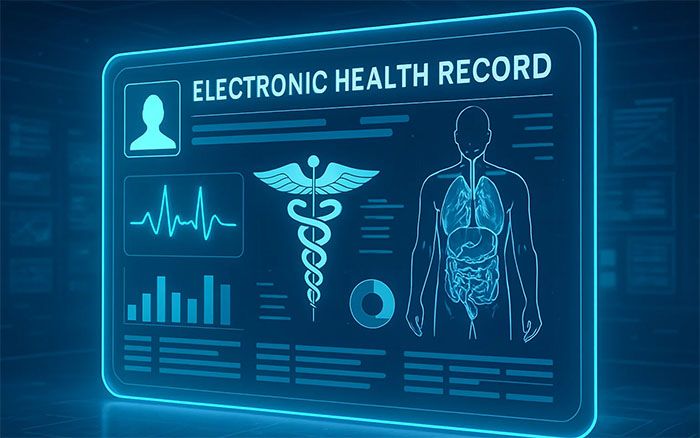Bridging the Gap Between Athletic and Wellness Departments on College Campuses
In the high-pressure world of college athletics, student-athletes juggle rigorous training schedules, academic responsibilities, and the everyday demands of college life. Ensuring these athletes remain in peak physical condition while maintaining their overall health is no small feat.
This challenge is especially prominent when athletic departments and campus health and counseling centers operate separately. That’s unless…You’re utilizing an integrated Electronic Health Record (EHR) system!
EHR solutions offer a seamless, efficient way to coordinate care between departments and ensure that student-athletes receive comprehensive support both on and off the field.
In this blog we’ll cover:
- The challenges of miscommunication between athletic departments, health centers, and counseling clinics
- How an EHR can bridge the gap to deliver a better student experience and more coordinated care
- The critical role of an EHR in supporting both the physical and mental health of student-athletes
The Disconnect Between Athletics and Campus Wellness
Athletic trainers manage student-athlete injuries and performance optimization on many campuses, while campus health centers handle general medical care and counseling handles mental health support.
With these three services operating independently, this makes it difficult to share critical health information that can impact an athlete’s overall well-being. This disconnect can result in delayed or incomplete care and missed opportunities for holistic health management.
The Role of an Integrated EHR in Coordinating Care for Student-Athletes
An integrated EHR platform addresses these challenges by creating a single, unified system that offers multiple benefits, including permission structures to maintain student privacy:
1. Improved Communication Sharing
A comprehensive EHR system allows both athletic trainers and wellness services staff to access shared student records, ensuring everyone involved in a student-athlete’s care is on the same page—but with safeguards in place.
Permission structures within the EHR ensure that only certain types of information or notes are visible to specific staff. For instance, a trainer may access medical history relevant to injuries but won’t see sensitive mental health notes unless permitted. This balance ensures privacy while improving overall care coordination.
Effective coordination among trainers, health services, and counseling services is essential for comprehensive student-athlete care. Here’s how it can look in practice:
- Trainers can view a student’s medical history before deciding on treatment for an injury.
- Health services can stay updated on any injuries or physical conditions when providing care.
- Counseling services can access relevant health information to better support a student’s overall well-being during treatment.
2. Seamless Coordination of Care
When athletic trainers and health services can collaborate through a shared EHR, they can coordinate care more effectively. For example, if an athlete is recovering from a concussion, trainers and wellness professionals can work together to develop a tailored recovery plan.
This accounts for physical, mental, and academic considerations. With all the information in one place, treatment plans can be updated in real-time, ensuring continuity of care.
4. Enhanced Tracking and Monitoring
An EHR system provides real-time access to data, making it easier to track athletes’ progress, monitor injuries, and manage recovery timelines.
Moreover, health professionals and trainers can quickly identify trends and adjust treatment plans as needed. This tracking is particularly beneficial for preventing recurring injuries or monitoring conditions like stress fractures or overuse injuries.
Hey! If you’re reading this blog, you might also be interested in our other blog, College Athletics and Mental Health. Check it out here.
5. Informed Decision-Making
Whether it’s a decision to return to play after an injury or addressing chronic issues like asthma or anxiety, integrated EHRs empower both athletic trainers and health services to make informed, data-driven decisions.
Furthermore, all clinics having access to comprehensive medical data ensure that student-athletes are not rushed back into play before they are fully ready, reducing the risk of re-injury.
Why Integration Matters for Mental Health
The physical demands of collegiate sports can take a toll on mental health. Anxiety, depression, and stress are common among student-athletes who balance competitive pressures, academic obligations, and personal lives. An integrated EHR streamlines communication and collaboration, improving overall care for student-athletes.
Sharing information on mental health services and treatment plans allows athletic trainers to recognize when an athlete might need extra support. This enables health and counseling services to intervene earlier if mental health issues are affecting athletic performance.
Key Takeaways
Coordinating care between athletic trainers and campus health and counseling centers is critical to ensuring that student-athletes receive comprehensive, holistic care. By implementing an integrated EHR solution, colleges and universities can break down silos, improve communication, and provide better care for their athletes.
And when these departments can seamlessly communicate, student-athletes can perform at their best—both on the field and off.















